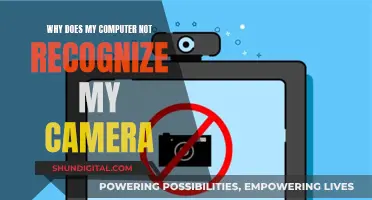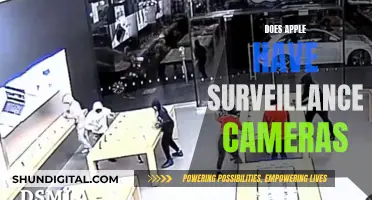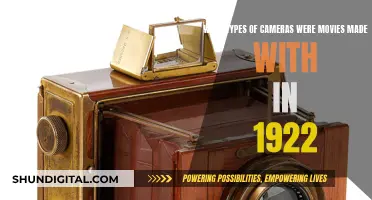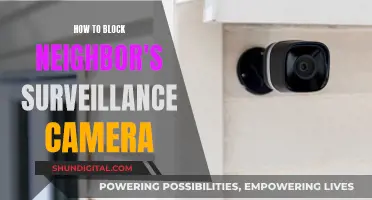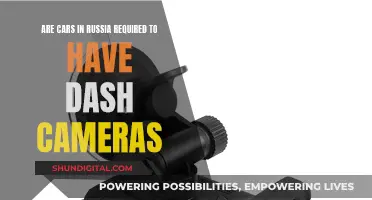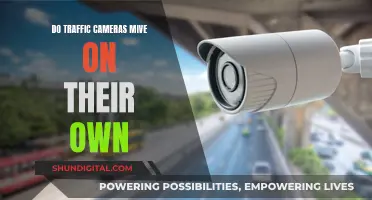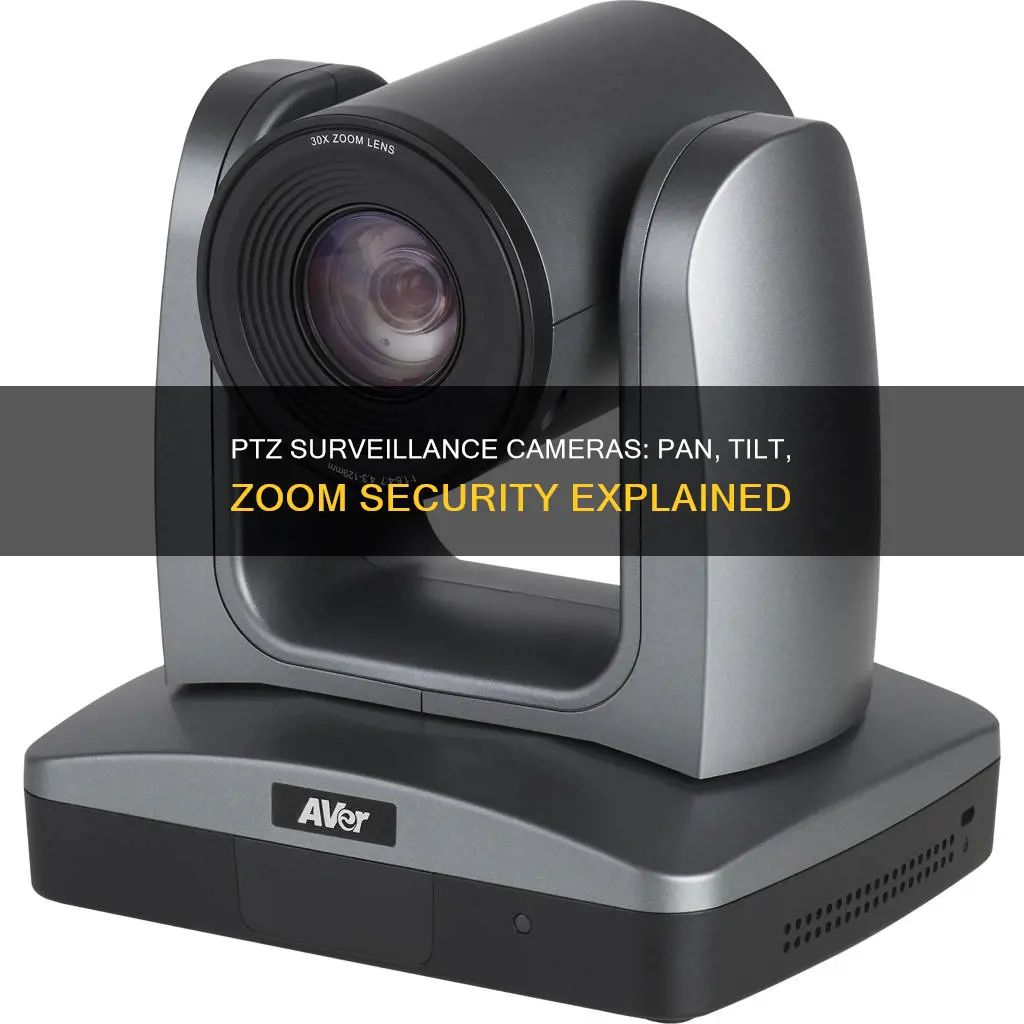
PTZ stands for pan, tilt, and zoom. PTZ cameras are ideal for surveillance and monitoring large areas as they can rotate left and right, tilt up and down, and zoom in and out. They are often used in guard stations and can be set to automatically follow motion-triggered activity. PTZ cameras are commonly used in stadiums, parking lots, transportation hubs, parks, and train yards. They are also useful for live streaming and video production, as they can be controlled remotely and offer more versatility compared to fixed-lens cameras.
| Characteristics | Values |
|---|---|
| Acronym | PTZ |
| Full Form | Pan-Tilt-Zoom |
| Use | Surveillance and streaming |
| Movement | Pan (rotate) left and right, tilt up and down, zoom in and out |
| Shape and Size | Available in a variety of shapes and sizes |
| Camera Movement | Controlled by servos and motors |
| Control | Controlled remotely from anywhere in the world via a smartphone app or computer software |
| Camera Type | Robotic |
| Field of View | 180 or 360 degrees |
| Automation | Can be set to automatically monitor motion-activated activities or adhere to a defined schedule |
| Image Quality | High |
| Installation | Wired or wireless |
| Durability | Less durable than fixed cameras due to more moving parts |
| Cost | More expensive than regular cameras |
What You'll Learn

PTZ cameras are ideal for surveillance and live streaming
PTZ cameras, or Pan-Tilt-Zoom cameras, are ideal for surveillance and live streaming. PTZ cameras can rotate left and right, tilt up and down, and zoom in and out, making them perfect for monitoring large areas and capturing detailed footage. They are often used in conjunction with a fixed camera to ensure comprehensive coverage.
The versatility of PTZ cameras makes them suitable for a wide range of applications, including security, live streaming, and video production. They can be controlled remotely via smartphone apps or computer software, making them a convenient and flexible option for capturing footage from multiple angles. PTZ cameras are also equipped with intelligent features such as motion detection and auto-tracking, which enable them to automatically follow and capture moving objects or individuals. This makes them particularly useful in quiet areas with minimal movement, such as museums or train yards.
One of the key advantages of PTZ cameras is their ability to provide wide-angle coverage and powerful zoom capabilities. They can monitor expansive areas with a 180-degree or 360-degree view, making them ideal for stadiums, parking lots, transportation hubs, and other large spaces. The zoom function allows for capturing detailed footage, such as license plates or faces, even from a distance.
Another benefit of PTZ cameras is their remote controllability. This enables users to adjust the camera's field of view without having to be onsite, making them convenient for live streaming and security applications. PTZ cameras can be easily integrated into a multi-camera setup, allowing for simultaneous use of multiple cameras placed in different locations.
However, it is important to consider some potential drawbacks of PTZ cameras. They may have security blind spots due to their moving parts, and their complex installation and higher cost compared to regular cameras are also factors to consider. Despite these limitations, PTZ cameras remain a popular choice for surveillance and live streaming due to their flexibility, advanced features, and ability to capture high-quality, detailed footage.
Vivint Camera Quiet Mode: What You Need to Know
You may want to see also

They can be controlled remotely from anywhere in the world
PTZ cameras, or Pan-Tilt-Zoom cameras, are ideal for surveillance and streaming as they can rotate left and right, tilt up and down, and zoom in and out. They can be controlled remotely from anywhere in the world via a smartphone app or computer software. This remote control feature allows for a multi-camera arrangement where several PTZ cameras can be placed at various locations and used simultaneously.
The remote control feature of PTZ cameras is particularly useful for live streaming. PTZ cameras are the best choice for live streaming video over the internet as they offer the most versatility for streaming because of their remote controllability in nearly all directions. Customers have used PTZ security cameras to stream a variety of events, including church services, zoo exhibits, natural wildlife habitats, and construction sites. They have also been used for live streaming weather stations, military explosive testing, and conference rooms.
PTZ cameras can be easily integrated into a system with other cameras. They can be set up to automatically monitor motion-activated activities or adhere to a defined schedule. They can also be programmed to cycle through preset viewpoints, follow tours, or automatically scan an area.
The remote control feature of PTZ cameras also allows users to change the camera's field of view without having to go onsite. This is especially useful for monitoring large areas.
Long Exposures: How They Affect Your Camera's Battery Life
You may want to see also

PTZ cameras are commonly used in sports broadcasting
PTZ cameras, or Pan-Tilt-Zoom cameras, are a type of surveillance camera with robotic capabilities. They can pan horizontally, tilt vertically, and zoom in and out, providing both wide-area coverage and detailed images. These cameras are widely used in sports broadcasting for several reasons.
Firstly, PTZ cameras offer unparalleled flexibility and precision in capturing sporting events. Their ability to pan, tilt, and zoom allows broadcasters to closely follow the action, ensuring that no thrilling moment is missed. This level of control results in crisp and clear images that engage audiences and elevate the viewing experience.
Secondly, PTZ cameras are highly versatile and portable. They can be easily set up in various locations, such as schools, stadiums, and production sets, without requiring a large camera crew. This versatility enhances the overall production quality of sports broadcasts by providing dynamic shots and immersive viewing experiences for the audience.
Moreover, PTZ cameras are ideal for sports broadcasting due to their auto-tracking and zoom capabilities. They can automatically detect and follow the movement of athletes, capturing both on-field and in-stadium activities. This feature is especially useful in fast-paced sports, ensuring that the camera keeps up with the intense action.
PTZ cameras have also bridged the gap between semi-professional and professional sports broadcasting. Their broadcast-quality coverage meets the demands of both levels, providing the precision and flexibility needed to capture the excitement and intensity of any game.
Lastly, PTZ cameras offer remote management capabilities. This feature is particularly useful for sports broadcasting as it allows operators to control the cameras from a distance, adjusting the field of view and zoom level as needed. This remote functionality enhances the efficiency of sports broadcasting by reducing the need for extensive on-site personnel.
In conclusion, PTZ cameras have revolutionized sports broadcasting by providing flexibility, precision, and high-quality output. They have become an invaluable tool for capturing every play, connecting fans, and elevating the overall sporting experience. With their advanced features and remote control options, PTZ cameras are the go-to choice for innovative solutions in the dynamic world of sports broadcasting.
Mobile Camera Focus: Unlocking the Magic Behind the Lens
You may want to see also

They are more expensive than regular cameras
PTZ cameras are more expensive to manufacture than regular cameras. They are built with mechanical parts and motors that allow them to swivel left to right, tilt up and down, and zoom in and out. This pan-tilt-zoom functionality gives operators maximum control over the camera's field of view, enabling them to monitor large areas and capture detailed footage.
The cost of a PTZ camera is often higher than that of a regular camera due to its advanced features and capabilities. PTZ cameras offer a larger field of view, covering a wide area with a single camera. They can be programmed to automatically follow motion-triggered activities or adhere to a pre-set schedule, ensuring efficient surveillance. Additionally, their powerful optical zoom capabilities allow for clear and sharp images at long distances, making them ideal for monitoring parking lots, entrances, and critical areas.
The durability of PTZ cameras should also be considered when comparing costs. Since they have many moving parts, they may be less durable than fixed solutions. It is important to look for cameras built with durability in mind, such as weather resistance and protection against impacts.
Furthermore, PTZ cameras often require additional equipment and integration with a larger surveillance system. They are typically used in conjunction with fixed cameras to ensure comprehensive coverage and detailed shots. The need for complementary equipment can increase the overall cost of the surveillance system.
In summary, PTZ cameras offer advanced features and capabilities that justify their higher cost compared to regular cameras. They provide enhanced monitoring, detailed footage, and flexible coverage, making them a valuable investment for surveillance and security purposes.
XA20 Camera Battery Life: How Long Does It Last?
You may want to see also

PTZ cameras are in high demand
PTZ cameras, or Pan-Tilt-Zoom cameras, are in high demand due to their versatility, advanced features, and cost-effectiveness.
PTZ cameras are highly versatile and can be used in a wide range of applications, from surveillance and security to live streaming and video production. They are ideal for monitoring large areas, such as stadiums, parking lots, and transportation hubs, as they can pan, tilt, and zoom to cover a wide field of view. This makes them a popular choice for ensuring crowd safety, monitoring critical infrastructure, and deterring criminal activities.
Additionally, PTZ cameras offer advanced features such as motion-based auto-tracking, remote control capabilities, and optical zoom. The ability to automatically track moving objects and adjust the field of view makes them highly effective for surveillance and security purposes. Remote control options, accessible via smartphone apps or computer software, allow users to operate the cameras from anywhere in the world, making them convenient and user-friendly. Furthermore, optical zoom capabilities enable users to capture clear and detailed images of faraway objects, enhancing the overall functionality of the camera.
Another factor contributing to the high demand for PTZ cameras is their cost-effectiveness. While they may have a higher upfront cost compared to traditional fixed cameras, PTZ cameras can provide equivalent or better results. With PTZ cameras, users can achieve high-quality visuals and automate their operations, reducing the need for manual labour. This makes them a cost-effective solution, especially for broadcasters, production companies, and entertainment venues looking to maintain quality while reducing operating costs.
The advancements in PTZ camera technology, such as improvements in sensors, IP technology, and the introduction of fanless designs, have also played a significant role in increasing their demand. These improvements have enhanced the image quality, stability, and versatility of PTZ cameras, making them more reliable and powerful tools for content creators, broadcasters, and security professionals.
In conclusion, PTZ cameras are in high demand due to their versatility, advanced features, and cost-effectiveness. Their ability to cover large areas, advanced tracking and zooming capabilities, remote control options, and cost-saving benefits make them a popular choice for a wide range of applications, from security and surveillance to live streaming and video production.
The Evolution of Ricoh Cameras: A Global Manufacturing Journey
You may want to see also
Frequently asked questions
PTZ stands for pan, tilt, and zoom. PTZ cameras are ideal for surveillance as they can rotate left and right, tilt up and down, and zoom in and out. They are often used to monitor large areas and can be controlled remotely.
PTZ cameras offer a wide field of view, powerful zoom capabilities, and automation features such as auto-scan and preset tour options. They can also be integrated with other cameras and are highly versatile due to their small form factor.
PTZ cameras may have blind spots during scans, preset tours, or auto-tracking movements. They can also be more expensive and prone to damage due to their moving parts. Additionally, there may be lag or latency issues when controlling the camera remotely.
PTZ cameras are commonly used in stadiums, parking lots, transportation hubs, parks, train yards, storage lots, warehouses, and loading docks. They are suitable for both indoor and outdoor use and can be placed in various locations, such as on walls or ceilings.


